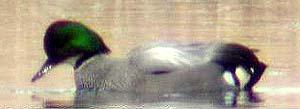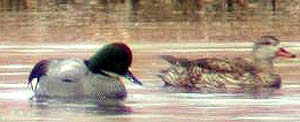Falcated Duck
Honey Lake, Lassen County, California
26-27 March 2002
Joseph Morlan
Photos © 21 March 2002 by Bruce Webb
 Robbie Fischer and I arrived
at Honey Lake about 4pm on our way to look for the Falcated Duck which had been in the area since 19 March 2002
when found by John Sterling. We encountered Vernon and Andrew Howe along Mapes Road south of Fish and Game Road.
They were looking for the Harris's Sparrow which had been seen previously in the area. Vernon advised us that the
Falcated Duck was still in its usual place and that if we didn't see it within one minute of getting out of the
car, we should quit birding.
Robbie Fischer and I arrived
at Honey Lake about 4pm on our way to look for the Falcated Duck which had been in the area since 19 March 2002
when found by John Sterling. We encountered Vernon and Andrew Howe along Mapes Road south of Fish and Game Road.
They were looking for the Harris's Sparrow which had been seen previously in the area. Vernon advised us that the
Falcated Duck was still in its usual place and that if we didn't see it within one minute of getting out of the
car, we should quit birding.
We arrived by the green and yellow flagging tape along Fish and Game Road 0.6 mi., east of Mapes Road to find many
Gadwall, American Wigeons and a few other ducks, but no Falcated Duck. We waited for over 30 minutes before the
Falcated Duck appeared in the pond across the levee on the north side of the road. We got excellent views of the
duck through our scopes. We also returned the next morning and observed the bird again in better light. The following
description is based on notes made while watching the bird:
A medium sized duck, about the size and shape of adjacent Gadwall, but with much iridescent green on the face,
a white collar around the neck with a black interior collar mark, and very long falcate shaped tertials hanging
over the rear of the bird forming a prominent bustle.
The body was vermiculated with a fine gray herring-bone pattern similar to Gadwall, but the breast was more coarsely
marked with black spotting, also similar to Gadwall. The flanks were whitish with a vertical black line dividing
the flank patches into two areas. The larger rear area was wedge-shaped and tinted with pale yellow. The smaller
front area was pure white. The scapulars were paler gray, speckled with black. The rump was black. The wing coverts
on the folded wing were largely concealed by elongated scapulars and tertials, but a patch of black (lesser coverts)
peeked through the gray sides. A small dark green patch (speculum)was barely visible just above the whitish flank
patch. It was located in the same area where the white patch shows up on the folded wing of a Gadwall.
The tertials were very elongated, falcate in shape. They were held up slightly by the tail and then hung down behind
the rump, giving the rear end an odd blunt appearance. These feathers were very narrow, black in color, but edged
in white.
The head had a strong green gloss to the face, extending back onto the nape where it formed a hanging pointed crest.
The crown and lower face were dark rusty. A narrow white collar with a black mid-line extended around the front
of the neck. The eye was dark. A small white headlight spot was just above the middle of the bill on the forehead.
The bill was black and about the size and shape of Gadwall.
The bird spent most of its time dabbling on the surface of the water, but did not dip its head under the water.
Its feet and legs were never visible. It associated mostly with Gadwall, and occasionally bobbed its head at nearby
female Gadwall in apparent courting attempts. The plumage was very fresh looking, and showed no obvious evidence
of wear or captivity
DISCUSSION
The California Bird Records Committee has reviewed two previous records of Falcated Duck in California, but neither
were accepted on the grounds of questionable natural occurrence:
5 Apr-21 May 1953 San Francisco SF 458-1986-14
2 Jan-21 Feb 1969 Upper Newport Bay ORA 128-1986-14
However, the species was added to the Supplemental List based on these records.
Another Falcated Duck was reported by John Trochet at the Gray Lodge Wildlife Management Area in Butte County
on 15 February 1998, but was apparently never submitted. This year a "possible" Falcated Duck was reported
by Melvin McKinney 28 March 2002 at the Elk River Wildlife Area, Eureka, Humboldt County but was not confirmed.
Elsewhere on the West Coast, another male Falcated Duck has been present at Samish Flats, Skagit Co., Washington
since 21 February 2002 (a photo is here), and there are
prior records from Vernon, British Columbia (15 April 1932), Tofino, British Columbia (19-22 April 1994, returning
late January-23 March 1995, and again 20 February 1996), and Willapa Bay, Washington. This pattern suggests that
Falcated Ducks may occasionally reach California naturally.
However, sightings from Ohio, Virginia, North Carolina, Ontario and Europe suggest that some records may be
of escaped captives. It is difficult to assess the status of this species in captivity although Todd (Waterfowl
of the World, 1979) states that it is reasonably common and bred in captivity. Searching the web for this species,
I found a pair for sale from a breeder in Wisconsin for $125, another pair for $140 from Montana, and a hen for
sale from a breeder in Michigan for $40. Also I elicited an opinion from Jeffrey Brown, a breeder in Applegate,
Oregon, who stated:
"I doubt highly that any falcated seen in the states are wild. I myself have had a few escapee's over
the years. In fact, if you see a red breasted goose flying around the northwest, its probably mine."
We met one of the rangers at the Honey Lake Wildlife Management Area who advised us that 12-15 birders had been
to see the bird each day and that some visitors came from as far away as New York.
Videos of this bird by Leslie Lieurance have been posted here
and here. To view the videos, you may need to download
QuickTime from Adobe here.

 Robbie Fischer and I arrived
at Honey Lake about 4pm on our way to look for the Falcated Duck which had been in the area since 19 March 2002
when found by John Sterling. We encountered Vernon and Andrew Howe along Mapes Road south of Fish and Game Road.
They were looking for the Harris's Sparrow which had been seen previously in the area. Vernon advised us that the
Falcated Duck was still in its usual place and that if we didn't see it within one minute of getting out of the
car, we should quit birding.
Robbie Fischer and I arrived
at Honey Lake about 4pm on our way to look for the Falcated Duck which had been in the area since 19 March 2002
when found by John Sterling. We encountered Vernon and Andrew Howe along Mapes Road south of Fish and Game Road.
They were looking for the Harris's Sparrow which had been seen previously in the area. Vernon advised us that the
Falcated Duck was still in its usual place and that if we didn't see it within one minute of getting out of the
car, we should quit birding.